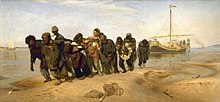Russian Museum
The Russian Museum in Saint Petersburg is the most comprehensive collection of Russian art , alongside Moscow's Tretyakov Gallery . The museum has around 315,000 exhibits from the fields of painting, sculpture, graphics, handicrafts and folk art.
history
The collection was originally created by Tsar Alexander III. created. Nicholas II acquired the Mikhailovsky Palace , in which it is housed today, as well as other works of art and supplemented the collection with partial holdings from the Hermitage and the Alexander Palace in Tsarskoye Selo . After the October Revolution, the collection continued to grow due to the expropriation of the Russian nobility. Almost the entire holdings of Russian art in the Hermitage also went to the Russian Museum.
In 1926 the Russian Museum received all of the holdings of the Leningrad Museum of Painting Culture , which opened in 1921. This gave the Russian Museum an important collection of modern art, including works by Olga Rosanova , Kasimir Malewitsch , Robert Falk , Lyubow Popova , Alexander Rodchenko , Nadezhda Udaltzova , Natalija Goncharova and many more.
building
The main building of the museum, the building ensemble of the Mikhailovsky Palace , was designed in 1819–1825 by the architect Carlo Rossi . The outside of the main building and the west wing have remained unchanged to this day. The opening took place on April 13, 1895.
The Russian Museum has three other palaces that house various important collections and regular exhibitions: The Stroganov Palace , the Michaelsburg and the Marble Palace . In addition, the little house of Peter the Great (Peter's first, simple wooden house from the time the city was founded) on Petrovskaya embankment and its branches in the Summer Palace in the summer garden of the Russian Museum are also located.
Collections
Today the collection includes works of Russian art from the icons of the 12th century to socialist realism. The museum also has an important collection of the Russian avant-garde . The most famous works include "The Apostle Peter and The Apostle Paul" (1408) by Andrei Rublev , "The Last Day of Pompeii" (1833) by Karl Brüllow , "Christ Appears to the People" (1836–1855) by Alexander Ivanov , “The ninth wave” (1850) by Iwan Aivazovsky , “ Die Wolgatreidler ” (1870–1873) by Ilja Repin , the “Walk” (1917) by Marc Chagall , “Suprematism” (1915–1916) by Kasimir Malewitsch and “ Composition No. 223 ”(1919) by Wassily Kandinsky .
On March 10, 1995, the Ludwig Museum was opened in the Russian Museum in the Marble Palace, which represents an extensive collection of international contemporary art. The collection contains important works since 1945, among others by Jasper Johns , Pablo Picasso , Jeff Koons , Jean-Michel Basquiat , Andy Warhol , Joseph Beuys , Ilja Kabakow , Jörg Immendorff , Werner Branz and Gottfried Helnwein .
Web links
- http://www.rusmuseum.ru/ ( Russian / English )
- Old Russian icons from the collection of the Russian Museum
- Ludwig Museum in the Russian Museum
- Russian Museum, Marble Palace (Saint Petersburg)
- Russian Museum, Mikhailovsky Palace (Saint Petersburg)
- Russian Museum, video tour of the palaces
Individual evidence
- ↑ a b Vladimir Gusev, Jevgenija Petrova: The Russian Museum, St. Petersburg 2005.
- ↑ Birgit Borowski: Baedeker Allianz travel guide St.Petersburg. Ostfildern 2007.
- ↑ Klaus M. Martinetz: Archive 2010: from across the border looked . Museum Ludwig in St. Petersburg. 15 years on the Neva. Retrieved June 11, 2018 .
Coordinates: 59 ° 56 ′ 19.5 ″ N , 30 ° 19 ′ 56.6 ″ E

